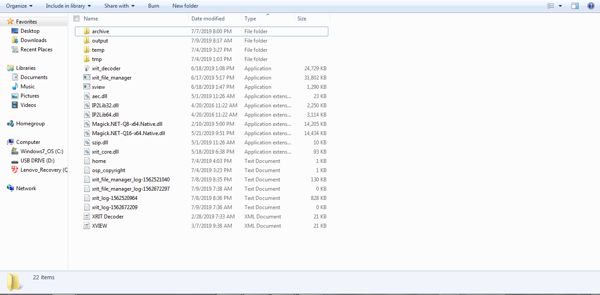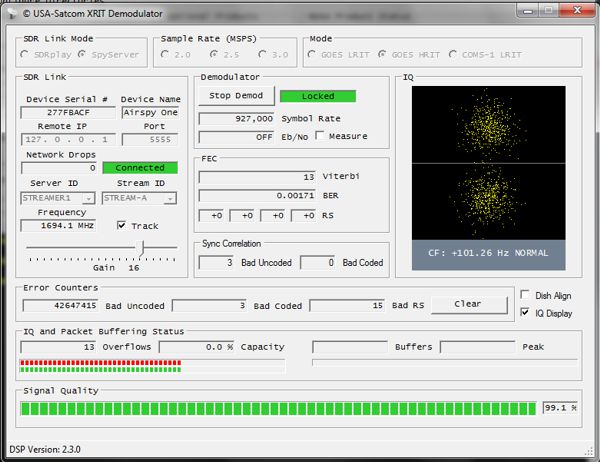
CLICK HERE for a detailed writeup with high-resolution pictures in .pdf format.
The GOES-East (GOES-16) satellite (GOES=Geostationary Operational Environmental Satellite) operated by NASA and the National Oceanic and Atmospheric Administration (NOAA) is exactly due south of my QTH and provides a view of Earth centered right at my longitude (75°W).
GOES-16 transmits two interesting direct services:
- The EMWIN (Emergency Managers Weather Information Network) service contains weather forecasts, warnings, graphics, and other information directly from the National Weather Service in near-real-time.
- The HRIT (High Rate Information Transmission) service broadcasts GOES satellite imagery data and other weather-related products.
I wanted to experiment with receiving these services from the GOES 16 satellite, and to do so, I added a small grid parabolic antenna to the Az/El boom that drives my 12’ EME dish. I purchased this antenna on eBay®. It is an Altelix WiFi 24dBi 2.4GHz parabolic dish with N-male connector that sells for $30:

The only modification that I made is to space the secondary reflector from the dipole feed to compensate for the difference between the desired and design frequency ranges for the antenna (1.69 GHz vs 2.4 GHz). I did this by adding two 1”-long 4-40 aluminum standoffs (McMaster-Carr 93505A436 Male-Female Threaded Hex Standoff, Aluminum, 1/4″ Hex Size, 1″ Long, 4-40 Thread Size) with two short 4-40 stainless-steel screws:

I mounted the LNA and SAW filter chain in a weatherproof, water-tight enclosure placed right at the antenna’s output:
 The front-end LNA is a Mini-Circuits ZX60-P103LN+, which is followed by a Nooelec SAWbird+ GOES. A second ZX60-P103LN+ is used as the cable driver. These three modules are fed with 5V (I have +12V and +5V DC/DC converters in my mast box which are fed from 12VDC from the shack). The amplified and filtered signal is sent to my shack through 100’ of LMR-400 coax cable.
The front-end LNA is a Mini-Circuits ZX60-P103LN+, which is followed by a Nooelec SAWbird+ GOES. A second ZX60-P103LN+ is used as the cable driver. These three modules are fed with 5V (I have +12V and +5V DC/DC converters in my mast box which are fed from 12VDC from the shack). The amplified and filtered signal is sent to my shack through 100’ of LMR-400 coax cable.

In the shack, the LMR400 is connected to the input of an Airspy R2 SDR, and then to a laptop via USB.
My QTH is in New Jersey (Latitude: 39.84°, Longitude: -74.93°), so using Dishpointer.com, I found that to pick up GOES 16 at 75.2W I need to point the antenna to an Azimuth of 180.4° and an Elevation of 43.9°. Since GOES 16 is smack south of me, a perfectly vertical polarization on my antenna matches the satellite’s vertical polarization with no skew.
GOES 16’s HRIT and telemetry signals come in very strong as shown by SDR#:

To decode the EMWIN/HRIT services, I purchased a copy of the USA-Satcom XRIT software by Joe Steinmetz (K6SAT). Installing the software was very easy, since all that I needed to do was to drop the contents of the .zip file of the latest version into a directory (XRIT then creates output, archive, and temporary directories on its own):

Per Joe’s recommendation, I set set spyserver.config file to a maximum sample rate of 2500000 to keep the USB rate as low as possible, and then ran spyserver.exe.
I opened the XRIT Demodulator, and selected a remote IP of 127.0.0.1 and port 5555 (to match the spyserver’s listening IP and port). Once I turned the demodulator on, and after setting the sensitivity to 15, a nice constellation was displayed in the IQ window. The signal quality meter hovered around 99% with no further adjustment:

Then, I turned on the XRIT Ingestor, which immediately started to generate .lrit files from the received data:

The file manager soon started generating .png image files, including beautiful high-resolution pictures such as the following full-disk image:

The USA-Satcom XRIT software is magnificently written and well maintained with frequent updates, so it runs flawlessly. It is very easy to understand, and I soon discovered the many interesting products that are transmitted over the EMWIN/HRIT channel, including weather maps, discussions, advisories, detailed images of storms, etc.

I also purchased the optional XVIEW module, which makes it a snap to generate animations from a succession of HRIT images.
Although all of these images and products can be downloaded for free from the Internet (from www.noaa.gov), having the possibility of receiving them directly from the satellite gives me the ability to use real-time information during emergencies that may completely disrupt Internet availability.
CLICK HERE for a detailed writeup with high-resolution pictures in .pdf format.
